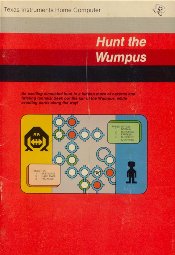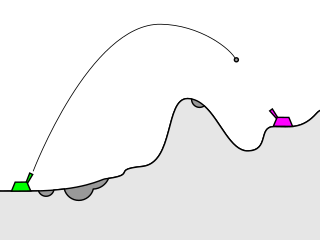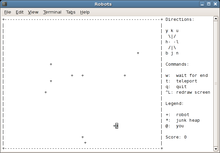
BASIC is a family of general-purpose, high-level programming languages designed for ease of use. The original version was created by John G. Kemeny and Thomas E. Kurtz at Dartmouth College in 1963. They wanted to enable students in non-scientific fields to use computers. At the time, nearly all computers required writing custom software, which only scientists and mathematicians tended to learn.

Hunt the Wumpus is a text-based adventure game developed by Gregory Yob in 1973. In the game, the player moves through a series of connected caves, arranged as the vertices of a dodecahedron, as they hunt a monster named the Wumpus. The turn-based game has the player trying to avoid fatal bottomless pits and "super bats" that will move them around the cave system; the goal is to fire one of their "crooked arrows" through the caves to kill the Wumpus. Yob created the game in early 1973 due to his annoyance at the multiple hide-and-seek games set in caves in a grid pattern, and multiple variations of the game were sold via mail order by Yob and the People's Computer Company. The source code to the game was published in Creative Computing in 1975 and republished in The Best of Creative Computing the following year.

True BASIC is a variant of the BASIC programming language descended from Dartmouth BASIC—the original BASIC. Both were created by college professors John G. Kemeny and Thomas E. Kurtz.

386BSD is a discontinued operating system based on the Berkeley Software Distribution (BSD) that was developed by couple Lynne and William Jolitz. Released on March 17, 1992, it was the first fully operational Unix operating system to be completely free and open source.
A multiplayer video game is a video game in which more than one person can play in the same game environment at the same time, either locally on the same computing system, on different computing systems via a local area network, or via a wide area network, most commonly the Internet. Multiplayer games usually require players to share a single game system or use networking technology to play together over a greater distance; players may compete against one or more human contestants, work cooperatively with a human partner to achieve a common goal, or supervise other players' activity. Due to multiplayer games allowing players to interact with other individuals, they provide an element of social communication absent from single-player games.
Dartmouth BASIC is the original version of the BASIC programming language. It was designed by two professors at Dartmouth College, John G. Kemeny and Thomas E. Kurtz. With the underlying Dartmouth Time Sharing System (DTSS), it offered an interactive programming environment to all undergraduates as well as the larger university community.
The Dartmouth Time-Sharing System (DTSS) is a discontinued operating system first developed at Dartmouth College between 1963 and 1964. It was the first successful large-scale time-sharing system to be implemented, and was also the system for which the BASIC language was developed. DTSS was developed continually over the next decade, reimplemented on several generations of computers, and finally shut down in 1999.

Planetfall is a science fiction themed interactive fiction computer game written by Steve Meretzky, and the eighth title published by Infocom in 1983. The original release included versions for Apple II, Atari 8-bit family, TRS-80, and IBM PC compatibles. The Atari ST and Commodore 64 versions were released in 1985. A version for CP/M was also released. Although Planetfall was Meretzky's first title, it proved one of his most popular works and a best-seller for Infocom; it was one of five top-selling titles to be re-released in Solid Gold versions including in-game hints. Planetfall uses the Z-machine originally developed for the Zork franchise and was added as a bonus to the "Zork Anthology".

Star Trek is a text-based strategy video game based on the Star Trek television series (1966–69) and originally released in 1971. In the game, the player commands the USS Enterprise on a mission to hunt down and destroy an invading fleet of Klingon warships. The player travels through the 64 quadrants of the galaxy to attack enemy ships with phasers and photon torpedoes in turn-based battles and refuel at starbases. The goal is to eliminate all enemies within a random time limit.

Space Travel is an early video game developed by Ken Thompson in 1969 that simulates travel in the Solar System. The player flies their ship around a two-dimensional scale model of the Solar System with no objectives other than to attempt to land on various planets and moons. The player can move and turn the ship, and adjust the overall speed by adjusting the scale of the simulation. The ship is affected by the single strongest gravitational pull of the astronomical bodies.
In computing, hardware overlay, a type of video overlay, provides a method of rendering an image to a display screen with a dedicated memory buffer inside computer video hardware. The technique aims to improve the display of a fast-moving video image — such as a computer game, a DVD, or the signal from a TV card. Most video cards manufactured since about 1998 and most media players support hardware overlay.

Mine Storm is a multidirectional shooter similar to Atari, Inc.'s 1979 Asteroids arcade game. Designed and programmed by John Hall, it was published in 1982 by General Consumer Electronics as the built-in game for the Vectrex system. Although not provided on a physical cartridge, a Mine Storm screen overlay and manual were included with each system to support the built-in game.

Wizard of Wor is an arcade video game released in 1981 by Midway. Up to two players fight together in a series of monster-infested mazes, clearing each maze by shooting the creatures. The game was ported to the Atari 8-bit family, Commodore 64(programmed by Jeff Bruette), Atari 2600, and Atari 5200 and renamed to The Incredible Wizard for the Bally Astrocade. The original cartridge came with a cash prize offer to the first person to complete the game.

Space Quest: Chapter I – The Sarien Encounter is a graphic adventure game, created by Scott Murphy and Mark Crowe, and released in October 1986 by Sierra On-Line. It is the first game in the Space Quest series, and sees players assume the role of a lowly janitor on a research ship, who becomes involved in stopping an alien race using a new form of technology for evil purposes.

Artillery games are two or three-player video games involving tanks trying to destroy each other. The core mechanics of the gameplay is almost always to aim at the opponent(s) following a ballistic trajectory. Artillery games are among the earliest computer games developed; the theme of such games is an extension of the original uses of computer themselves, which were once used to calculate the trajectories of rockets and other related military-based calculations. Artillery games have been described as a type of "shooting game", though they are more often classified as a type of strategy video game.

The Berkeley Software Distribution or Berkeley Standard Distribution (BSD) is a discontinued operating system based on Research Unix, developed and distributed by the Computer Systems Research Group (CSRG) at the University of California, Berkeley. The term "BSD" commonly refers to its open-source descendants, including FreeBSD, OpenBSD, NetBSD, and DragonFly BSD.

BASIC Computer Games is a compilation of type-in computer games in the BASIC programming language collected by David H. Ahl. Some of the games were written or modified by Ahl as well. Among its better-known games are Hamurabi and Super Star Trek.
Mainframe computers are computers used primarily by businesses and academic institutions for large-scale processes. Before personal computers, first termed microcomputers, became widely available to the general public in the 1970s, the computing industry was composed of mainframe computers and the relatively smaller and cheaper minicomputer variant. During the mid to late 1960s, many early video games were programmed on these computers. Developed prior to the rise of the commercial video game industry in the early 1970s, these early mainframe games were generally written by students or employees at large corporations in a machine or assembly language that could only be understood by the specific machine or computer type they were developed on. While many of these games were lost as older computers were discontinued, some of them were ported to high-level computer languages like BASIC, had expanded versions later released for personal computers, or were recreated for bulletin board systems years later, thus influencing future games and developers.
The History of the Berkeley Software Distribution begins in the 1970s.














